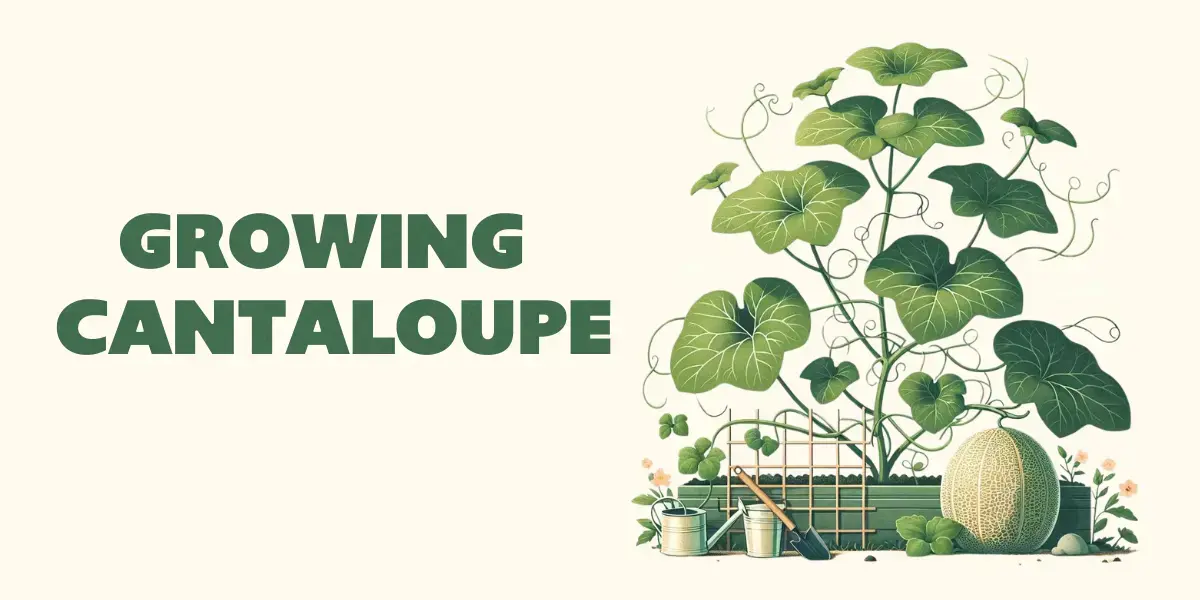“Cantaloupe” is hard to spell, but easy to grow.
This fruiting vine traces its roots to Egypt and Central Asia, dating back to around 2400 BCE.
In Italy, cantaloupe cultivation rose with the Renaissance and, by the 15th century, had spread to Spain and ultimately the New World.
Luckily for LA-area gardeners, the scrumptious “muskmelon” is a warm-season crop that thrives in heat and sun — i.e., Southern California summers.
Choosing the Right Variety for Southern California
-
- Ambrosia cantaloupes have creamy flesh and a mesh-like rind. They perform splendidly in hot climates.
- Hale’s Best Jumbo is an heirloom variety prized for its sweet, aromatic taste. It’s well-suited for the warm conditions of Southern California and has a relatively short growing season.
- Athena cantaloupes are known for their large size and thick, juicy flesh. They also have a long shelf life, making them a great option for storing.
- Charentais cantaloupes are a French variety that has gained popularity for its intensely sweet flavor and compact, round shape. Their small size and short growing season make them a top choice for gardeners with limited space.
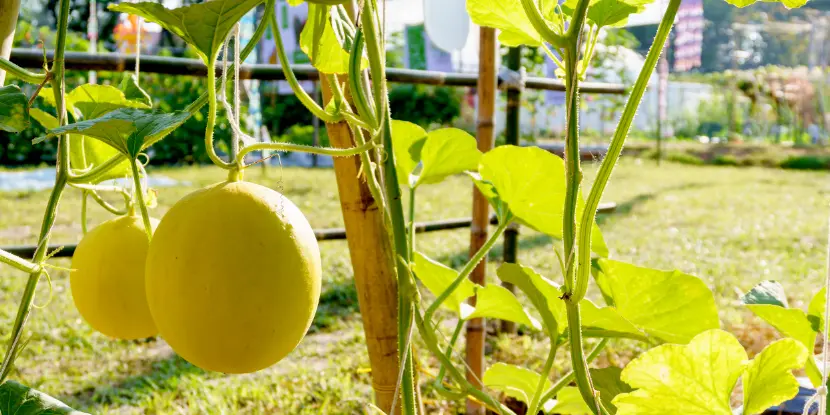
Yellow cantaloupes supported by a bamboo structure.
Starting Cantaloupe from Seed
- Start your cantaloupes indoors 4–6 weeks before the last expected frost in your area.
- Fill seed trays or small pots with a high-quality seed starting mix. Keep the soil moist but not soggy.
- Plant 2–3 seeds per pot, approximately 1/2 inch deep. Lightly cover the seeds with soil and gently press down to ensure good seed-to-soil contact.
- After planting the seeds, water the soil lightly. Cover the seed trays with a clear plastic lid or plastic wrap to maintain humidity while the seeds germinate.
- Place the seed trays in a warm location, ideally between 75-85°F (24-29°C). Once the seeds have germinated, remove the plastic cover and place the trays under grow lights or in a sunny window for 12-16 hours a day.
- Once the seedlings have two sets of true leaves, thin them out by snipping off the weaker plants at the soil level, leaving the strongest seedling in each pot.
- A week before transplanting, harden off the seedlings by gradually exposing them to outdoor conditions for a few hours daily.
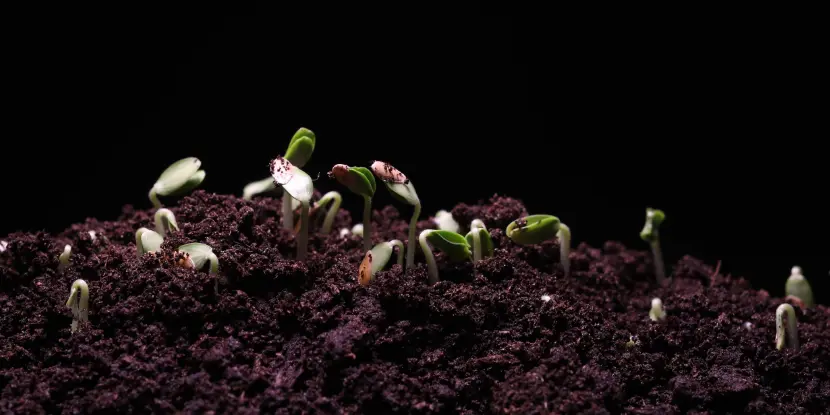
Newly sprouted cantaloupe seedlings.
Preparing Your Garden
Choose a Sunny Location
- Your garden should receive full sun for at least 6-8 hours daily.
- The area should drain well to prevent root rot.
- If you’re planting in a container, make sure it has drainage holes.
Soil Preparation
- Cantaloupes prefer fertile, loamy soil with a pH of 6.0-6.8.
- Before planting, work compost or aged manure into the soil to provide nutrients and improve drainage.
- If your soil is heavy clay, mix in sand or vermiculite to help drainage.
- Add a layer of mulch around the base of the plants to retain moisture and suppress weeds.
Planting Your Cantaloupe
Transplant your seedlings into the garden when daytime temperatures reach 70°F (21°C). Dig a hole twice the size of the root ball and gently remove the seedling from its pot.
Planting in Rows or Mounds
- Rows: Space your rows 3–4 feet apart to allow room for vine growth. Plant seedlings 18–24 inches apart within each row. This spacing helps air circulation, reducing the risk of disease.
- Mounds: Alternatively, create small mounds or hills about 3 feet apart. Plant 2–3 seedlings per mound. Mounds can improve drainage and soil temperatures.
Water your transplanted seedlings generously immediately after planting.
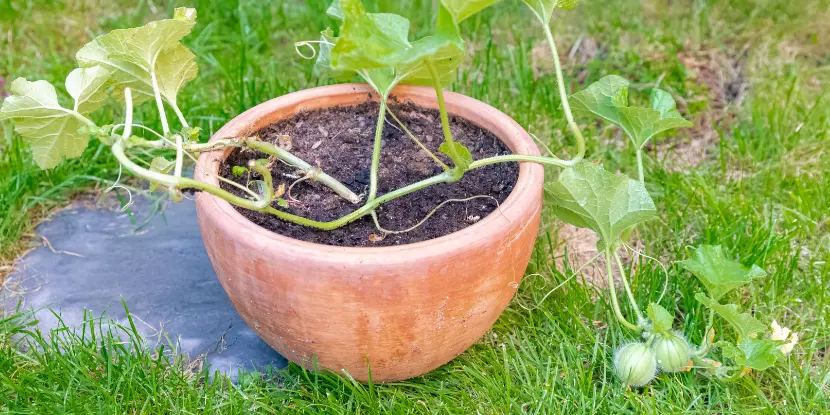
A container-grown cantaloupe vine with young melons.
Growing Tips
- Water plants deeply once a week or more frequently if the weather is unusually hot and dry.
- Fertilize your plants every 2–3 weeks with a balanced fertilizer.
- Train the vines to grow up a trellis or fence to save space. Gently tie the vines to the support structure with soft ties or old pantyhose.
- If growing in containers, use a large pot with at least 5 gallons of soil for each plant. Keep the soil evenly moist but not saturated.
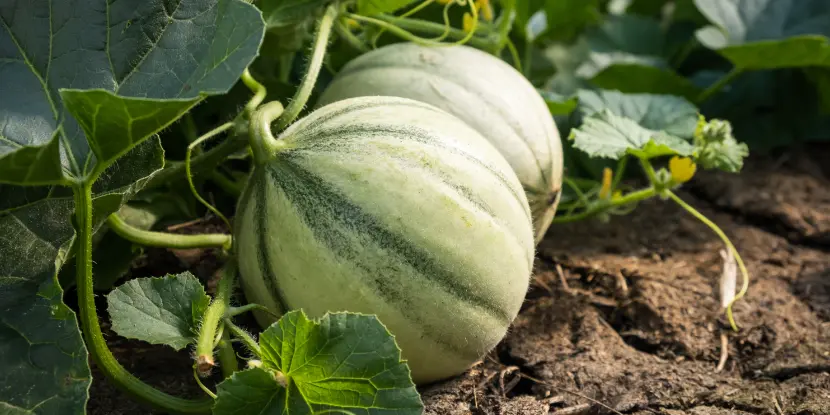
Unripe cantaloupe fruit on the vine.
Controlling Pests & Diseases Organically
- Melons are susceptible to a few pests and diseases, including aphids, cucumber beetles, and powdery mildew.
- To deter pests, use companion planting techniques by interplanting aromatic herbs like basil or marigolds. Planting flower varieties like dill, fennel, and alyssum nearby encourages beneficial predators like ladybugs, lacewings, and parasitic wasps.
- Avoid overhead watering and provide adequate air circulation by spacing plants properly to prevent disease.
- If disease does occur, remove affected leaves or plants immediately to prevent spread.
Harvesting & Storing Cantaloupe
Harvest your cantaloupes when they’re fully ripe to enjoy the sweetest flavor. The fruits should easily separate from the vine with a slight tug.
To store your cantaloupes, keep them at room temperature for a few days to ripen fully. Once ripe, store in the refrigerator for up to 5 days.
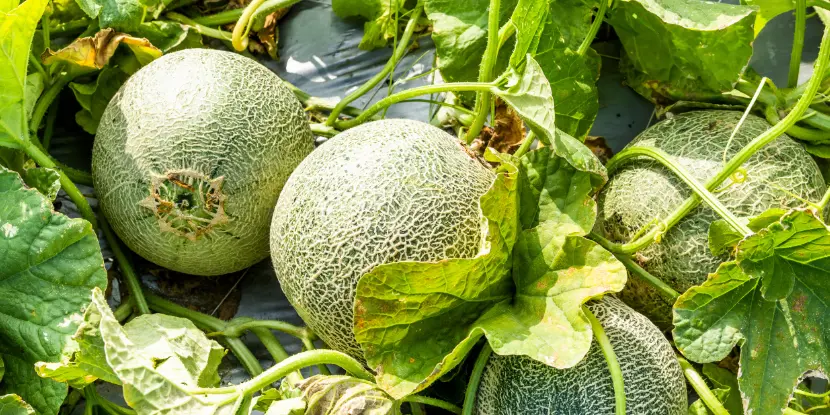
Cantaloupe fruit approaching maturity.
FAQs: Growing Cantaloupe
Q: How long does it take for cantaloupe to grow from seed to harvest?
Cantaloupe typically takes 70 to 90 days from planting seeds to harvest. This timeline can vary slightly depending on the variety you’re growing and the growing conditions.
What should I do if my cantaloupe plants aren’t producing fruit?
One possibility is that the plants aren’t getting enough sunlight or nutrients. Also, make sure the plants are adequately pollinated, either by hand-pollinating or attracting pollinators like bees to your garden.
Q: Can I save seeds from my cantaloupe for next year’s crop?
Yes, you can save seeds from your cantaloupe to plant in the following growing season. Choose ripe fruits and allow them to cure for a few days before extracting and drying the seeds.
Q: How much water do cantaloupe plants need?
Cantaloupe plants require consistent moisture, especially during the fruiting period. Water deeply once a week or more often during extreme heat.
Q: What’s the best way to fertilize cantaloupe plants?
Use a balanced fertilizer every 2–3 weeks throughout the growing season. Start with a higher nitrogen fertilizer to encourage leaf growth early on, then switch to phosphorus and potassium-rich fertilizer to support fruit development as the plants begin to flower.
Q: Why are my cantaloupe leaves turning yellow?
Yellowing leaves can indicate nutrient deficiency, poor drainage, or pest infestation. Check your soil’s pH and nutrient levels, improve drainage if necessary, and inspect the plants for signs of pests like aphids or spider mites.
Q: How can I tell when my cantaloupe is ready to harvest?
A ripe cantaloupe will emit a sweet fragrance, and the skin color will change from green to a golden tan. The fruit should easily detach from the vine with a slight tug. Another indicator of ripeness is the slightly yielding flesh at the blossom end when gently pressed.
Q: Can I grow cantaloupe in a greenhouse?
Yes, provided you maintain warm temperatures and good ventilation. Use trellises to support the vines and establish adequate spacing and air circulation.
Q: How do I prevent powdery mildew on my cantaloupe plants?
Ensure proper plant spacing for good air circulation and avoid overhead watering. Apply fungicidal sprays if necessary, and remove any infected leaves promptly. Growing resistant varieties can also mitigate this issue.
Q: What companion plants are beneficial for cantaloupe?
Companion plants like marigolds, nasturtiums, and radishes can deter pests and improve growth. Aromatic herbs such as basil and oregano can also repel harmful insects and attract beneficial pollinators to your garden.

